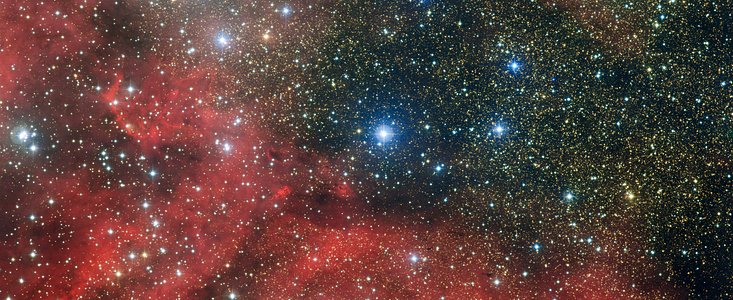Persbericht
Een sterrenhoop in een sterrenhoop
25 april 2012
Deze nieuwe opname, gemaakt met de Wide Field Imager van de 2,2-meter MPG/ESO-telescoop van de La Silla-sterrenwacht in Chili, toont de sterrenhoop NGC 6604. Deze wordt vaak over het hoofd gezien ten gunste van de naburige Adelaarnevel (ook bekend als Messier 16). Maar de kadrering van deze foto, die de sterrenhoop in een landschap van omringende gas- en stofwolken plaatst, bewijst dat NGC 6604 een prachtobject op zich is.
NGC 6604 is het heldere groepje linksboven op deze foto. Het is een jonge sterrenhoop die het dichtst opeengepakte gedeelte van een losser verband van ongeveer honderd heldere, blauwwitte sterren vormt [1]. Deze foto toont ook de nevel waarmee de sterrenhoop verbonden is – een wolk van gloeiend waterstofgas die Sh2-54 wordt genoemd [2] – evenals een aantal stofwolken.
NGC 6604 staat op een afstand van ongeveer 5500 lichtjaar in het sterrenbeeld Slang, ongeveer twee graden ten noorden van de Adelaarnevel (eso0926). De heldere sterren zijn gemakkelijk waarneembaar met een kleine telescoop en werden in 1784 voor het eerst opgetekend door William Herschel. De zwakke gaswolk ontsnapte echter aan iedere aandacht, totdat deze in de jaren vijftig van de afgelopen eeuw door Stewart Sharpless werd opgemerkt op fotografische platen van de National Geographic-Palomar Sky Atlas.
De hete jonge sterren stimuleren de vorming van een nieuwe generatie van sterren in NGC 6604 door met hun krachtige sterrenwinden en intense straling gas bijeen te blazen. Deze tweede generatie van sterren zal de vorige spoedig verdringen, want hoewel de helderste jonge sterren een enorme massa hebben, gaan ze zo kwistig met hun brandstof om dat ze maar kort leven.
NGC 6604 trekt niet alleen om esthetische redenen de aandacht van astronomen: het is het beginpunt van een vreemde zuil van heet, geïoniseerd gas. Vergelijkbare zuilen van heet gas, die het uitstromende materiaal van jonge sterrenhopen kanaliseren, zijn ook elders in de Melkweg en in andere spiraalstelsels aangetroffen, maar het voorbeeld in NGC 6604 is relatief dichtbij, waardoor astronomen het gedetailleerd kunnen bestuderen.
Deze specifieke zuil (door astronomen vaak ‘schoorsteen’ genoemd) staat loodrecht op het vlak van de Melkweg en is maar liefst 650 lichtjaar lang. Astronomen denken dat de hete sterren in NGC 6604 verantwoordelijk zijn voor het ontstaan van deze schoorsteen, maar om deze vreemde structuren volledige te begrijpen is meer onderzoek nodig.
Noten
[1] Deze verzameling sterren heet Serpens OB. ‘Serpens’ is de Latijnse naam van het sterrenbeeld Slang, en de letters ‘OB’ verwijzen naar het spectraaltype van de sterren. O en B zijn de twee heetste stercategorieën, en de meeste sterren van deze spectraalklassen zijn relatief jonge, heldere, blauwwitte sterren.
[2] De aanduiding Sh2-54 betekent dat dit het 54ste object in de tweede Sharpless-catalogus van HII-gebieden (wolken van gloeiend waterstofgas) is.
Meer informatie
Het jaar 2012 staat in het teken van de vijftigste verjaardag van de oprichting van de Europese Zuidelijke Sterrenwacht (ESO). ESO is de belangrijkste intergouvernementele astronomische organisatie in Europa en de meest productieve sterrenwacht ter wereld. Zij wordt ondersteund door vijftien landen: België, Brazilië, Denemarken, Duitsland, Finland, Frankrijk, Italië, Nederland, Oostenrijk, Portugal, Spanje, Tsjechië, het Verenigd Koninkrijk, Zweden en Zwitserland. ESO voert een ambitieus programma uit, gericht op het ontwerpen, bouwen en beheren van grote sterrenwachten die astronomen in staat stellen om belangrijke wetenschappelijke ontdekkingen te doen. Ook speelt ESO een leidende rol bij het bevorderen en organiseren van samenwerking op astronomisch gebied. ESO beheert drie waarnemingslocaties van wereldklasse in Chili: La Silla, Paranal en Chajnantor. Op Paranal staan ESO’s Very Large Telescope (VLT), de meest geavanceerde optische sterrenwacht ter wereld, en twee surveytelescopen: VISTA werkt in het infrarood en is de grootste surveytelescoop ter wereld en de VLT Survey Telescope is de grootste telescoop die uitsluitend is ontworpen om de hemel in zichtbaar licht in kaart te brengen. ESO is ook de Europese partner van de revolutionaire telescoop ALMA, het grootste astronomische project van dit moment. Daarnaast bereidt ESO momenteel de bouw voor van de Europese Extremely Large optical/near-infrared Telescope (E-ELT), een telescoop van de 40-meterklasse die ‘het grootste oog op de hemel’ ter wereld zal worden.
Links
- Foto’s van de 2,2-meter MPG/ESO telescoop
- Andere foto’s die met de 2,2-meter MPG/ESO telescoop zijn gemaakt
- Foto’s van de ESO-sterrenwacht op La Silla
Contact
Richard Hook
ESO, La Silla, Paranal, E-ELT and Survey Telescopes Public Information Officer
Garching bei München, Germany
Tel: +49 89 3200 6655
Mob: +49 151 15 37 35 91
E-mail: rhook@eso.org
Rodrigo Alvarez (press contact België)
ESO Science Outreach Network
en Planetarium, Royal Observatory of Belgium
Tel: +32-2-474 70 50
E-mail: eson-belgië@eso.org
Over dit bericht
| Persberichten nr.: | eso1218nl-be |
| Naam: | NGC 6604 |
| Type: | Milky Way : Star : Grouping : Cluster |
| Facility: | MPG/ESO 2.2-metre telescope |
| Instruments: | WFI |
Our use of Cookies
We use cookies that are essential for accessing our websites and using our services. We also use cookies to analyse, measure and improve our websites’ performance, to enable content sharing via social media and to display media content hosted on third-party platforms.
ESO Cookies Policy
The European Organisation for Astronomical Research in the Southern Hemisphere (ESO) is the pre-eminent intergovernmental science and technology organisation in astronomy. It carries out an ambitious programme focused on the design, construction and operation of powerful ground-based observing facilities for astronomy.
This Cookies Policy is intended to provide clarity by outlining the cookies used on the ESO public websites, their functions, the options you have for controlling them, and the ways you can contact us for additional details.
What are cookies?
Cookies are small pieces of data stored on your device by websites you visit. They serve various purposes, such as remembering login credentials and preferences and enhance your browsing experience.
Categories of cookies we use
Essential cookies (always active): These cookies are strictly necessary for the proper functioning of our website. Without these cookies, the website cannot operate correctly, and certain services, such as logging in or accessing secure areas, may not be available; because they are essential for the website’s operation, they cannot be disabled.
Functional Cookies: These cookies enhance your browsing experience by enabling additional features and personalization, such as remembering your preferences and settings. While not strictly necessary for the website to function, they improve usability and convenience; these cookies are only placed if you provide your consent.
Analytics cookies: These cookies collect information about how visitors interact with our website, such as which pages are visited most often and how users navigate the site. This data helps us improve website performance, optimize content, and enhance the user experience; these cookies are only placed if you provide your consent. We use the following analytics cookies.
Matomo Cookies:
This website uses Matomo (formerly Piwik), an open source software which enables the statistical analysis of website visits. Matomo uses cookies (text files) which are saved on your computer and which allow us to analyze how you use our website. The website user information generated by the cookies will only be saved on the servers of our IT Department. We use this information to analyze www.eso.org visits and to prepare reports on website activities. These data will not be disclosed to third parties.
On behalf of ESO, Matomo will use this information for the purpose of evaluating your use of the website, compiling reports on website activity and providing other services relating to website activity and internet usage.
Matomo cookies settings:
Additional Third-party cookies on ESO websites: some of our pages display content from external providers, e.g. YouTube.
Such third-party services are outside of ESO control and may, at any time, change their terms of service, use of cookies, etc.
YouTube: Some videos on the ESO website are embedded from ESO’s official YouTube channel. We have enabled YouTube’s privacy-enhanced mode, meaning that no cookies are set unless the user actively clicks on the video to play it. Additionally, in this mode, YouTube does not store any personally identifiable cookie data for embedded video playbacks. For more details, please refer to YouTube’s embedding videos information page.
Cookies can also be classified based on the following elements.
Regarding the domain, there are:
- First-party cookies, set by the website you are currently visiting. They are stored by the same domain that you are browsing and are used to enhance your experience on that site;
- Third-party cookies, set by a domain other than the one you are currently visiting.
As for their duration, cookies can be:
- Browser-session cookies, which are deleted when the user closes the browser;
- Stored cookies, which stay on the user's device for a predetermined period of time.
How to manage cookies
Cookie settings: You can modify your cookie choices for the ESO webpages at any time by clicking on the link Cookie settings at the bottom of any page.
In your browser: If you wish to delete cookies or instruct your browser to delete or block cookies by default, please visit the help pages of your browser:
Please be aware that if you delete or decline cookies, certain functionalities of our website may be not be available and your browsing experience may be affected.
You can set most browsers to prevent any cookies being placed on your device, but you may then have to manually adjust some preferences every time you visit a site/page. And some services and functionalities may not work properly at all (e.g. profile logging-in, shop check out).
Updates to the ESO Cookies Policy
The ESO Cookies Policy may be subject to future updates, which will be made available on this page.
Additional information
For any queries related to cookies, please contact: pdprATesoDOTorg.
As ESO public webpages are managed by our Department of Communication, your questions will be dealt with the support of the said Department.






